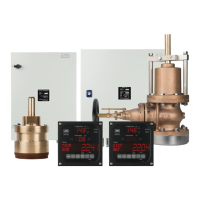10-4
2 Technical Specification
2.1 Performance data
Working principle: Acoustic correlation
Operating frequencies: Jumping frequencies in the range 3.8 MHz to 4.2 MHz
Measuring distance: 130 mm from the surface of the transducer.
Speed Range: +/- 50 knots sensed speed
Speed Accuracy: Better than 1% or 0.1 knots relative to sensed water flow
whichever is the greatest
Distance Accuracy: Better than 1%
2.2 Electrical specification
Input voltage: 8V – 15V DC (internal supply from Sig.Processor)
Power consumption: < 30 VA nominal
Main Speed output: IEC 61162-1 / NMEA0183. Serial driver RS 422; max load
100 ohm (10 Main displays)
Alarm relay outputs: Switching relay, default setting: power failure (30V/2A
recommended max load)
Serial input: used for PC interface / software update
2.3 User interfaces
LED (external status): LED 1 => Log fail alarm inactive,
Led is turned off if log fail alarm activates.
LED 2 => Default settings applied,
LED is turned off if default settings changed.
LED 3 => Signal Quality OK,
LED is turned on if measure exceeds a predefined
quality threshold.
LED 4 => Measuring,
LED toggles for each new speed calculation.
LED 5 => Application alive,
LED toggles each time the watchdog is kicked.
LED (internal status): LED 6 => ADC OK,
LED is turned off if LVDS receiver doesn't lock
on incoming data.
LED 7 => Data qualified OK,
LED is turned off if cycle, transmitter and/or
receiver timing don't match (internal SW error).
LED 8 => Data write OK,
LED is turned off if FIFO is full or an internal
error occurred.
LED 9 => Data read OK,
LED is turned off if FIFO overflows.

